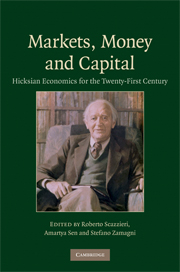Book contents
- Frontmatter
- Contents
- List of figures
- List of tables
- List of contributors
- Preface and acknowledgments
- Between theory and history: on the identity of Hicks's economics
- Part I The Intellectual Heritage of John Hicks
- Part II Markets
- Part III Money
- 11 Historical stylizations and monetary theory
- 12 Hicks: money, prices, and credit management
- 13 Core, mantle, and industry: a monetary perspective of banks' capital standards
- 14 A suggestion for simplifying the theory of asset prices
- Part IV Capital and Dynamics
- References
- Name index
- Subject index
14 - A suggestion for simplifying the theory of asset prices
Published online by Cambridge University Press: 29 June 2009
- Frontmatter
- Contents
- List of figures
- List of tables
- List of contributors
- Preface and acknowledgments
- Between theory and history: on the identity of Hicks's economics
- Part I The Intellectual Heritage of John Hicks
- Part II Markets
- Part III Money
- 11 Historical stylizations and monetary theory
- 12 Hicks: money, prices, and credit management
- 13 Core, mantle, and industry: a monetary perspective of banks' capital standards
- 14 A suggestion for simplifying the theory of asset prices
- Part IV Capital and Dynamics
- References
- Name index
- Subject index
Summary
Introduction
In the opening pages of his essay ‘A Suggestion for Simplifying the Theory of Money,’ John Hicks (1935a) describes his uneasiness as a non-monetary economist trying to deal with a subject, the theory of money at that time, completely deprived of the basic result of the theory of value – i.e. ‘that the relative value of two commodities depends upon their relative marginal utility’: ‘To an ingénu, who comes over to monetary theory,’ he writes ‘it is extremely trying to be deprived of this sheet-anchor. It was marginal utility that really made sense of the theory of value … What is wanted is a “marginal revolution”’ (ibid.: 2).
The same feeling could be perceived by a non-financial economist trying to deal with the theory of asset prices and, more generally, the value of uncertain prospects.
At its very beginnings, in the seventeenth century, the value of an uncertain prospect (i.e. a random variable, in modern language) was defined by its expected value, or just ‘value.’ Christiaan Huygens's (1692 [1657]) book represented, coming as it did just after the years of the Pascal–Fermat correspondence, a milestone in theoretical development: ‘He was trying to justify a method for pricing gambles which happens to be the same as what we call mathematical expectation’ (Hacking, 1975: 95).
- Type
- Chapter
- Information
- Markets, Money and CapitalHicksian Economics for the Twenty First Century, pp. 252 - 274Publisher: Cambridge University PressPrint publication year: 2009

